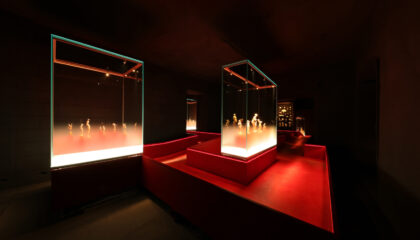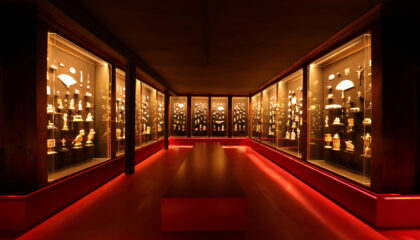Elfenbeinmuseum
Erbach, Germany
2016
Located in the Odenwald Mountains, the Erbach castle houses the Deutsches Elfenbeinmuseum (German Ivory Museum), a testimony to this trade’s vital relationship to the Hessian region’s cultural and industrial history. Towards the end of the eighteenth century, after years spent studying in various cultural and political capitals of Europe, Count Franz I returned to Germany and in 1783 founded a school for horn and ivory carving in Erbach. He wanted to improve the dire economic straits in which the region was languishing by producing and selling precious objects of practical and ornamental use. Erbach gradually became a center of highly skilled ivory carving, which in turn gave rise in the twentieth century to a whole new industry based on plastic injection molding, now internationally renowned owing to the Koziol trademark. Count Franz’s spirit and visionary energy were crucial in prompting the social, cultural and economic reforms that were needed to trigger the community’s rebirth. This spirit lies at the heart of the new exhibition.
Exhibit Design: Sichau & Walter Architekten GmbH, Fulda, Germany
The exhibition design
The exhibition begins in a “black box”, a darkened mirrored room that provides an immersive multimedia journey of discovery into the world of Franz I and his ideals. The exhibition then wends through the darkened rooms of Erbach castle along a route picked out by red lights, past display cases designed to appear as columns of light that float in the atmospheric dark. Lacking a base or frame and with partially frosted glass sides, the cases seem to emerge from a mist. The vitrines thus create a mood of mystery that invites contemplation of the superb carved works bearing witness to the timeless creative genius and remarkable cultural contributions of the region’s artisans. The visitor senses but does not directly experience the building’s architecture in the total darkness. The vitrines combine an extremely clean, highly geometric design with painstaking attention to detail to create an installation in which the cases and the works within join forces to astonish and amaze the visitor. Taking to heart the principle that less is more, the exhibit designers collaborated closely with the castle’s management to select pieces that are both fully realized in themselves and perfectly representative of a whole category.
The display cases
The display cases for this exhibition all belong to Goppion’s line with the best performance and affording the highest degree of customization. Featuring outstanding airtightness (10-day air exchange rate), these cases are especially tall and narrow, a combination that required meticulous experimentation to ensure structural stability. The in situ mounting operation was equally complex, requiring a crane with a twenty-meter boom to lift the glass panes of the larger cases up to the first floor of the castle and pass them through a window.





